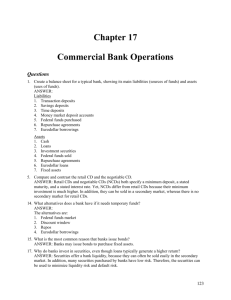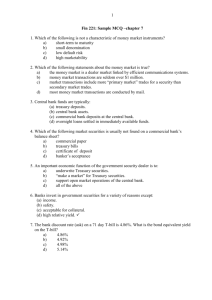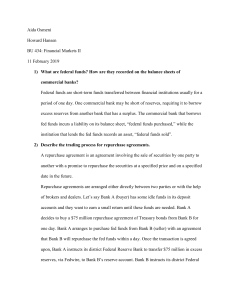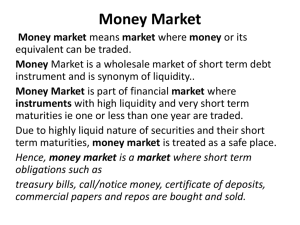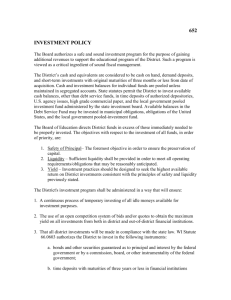chap7
advertisement
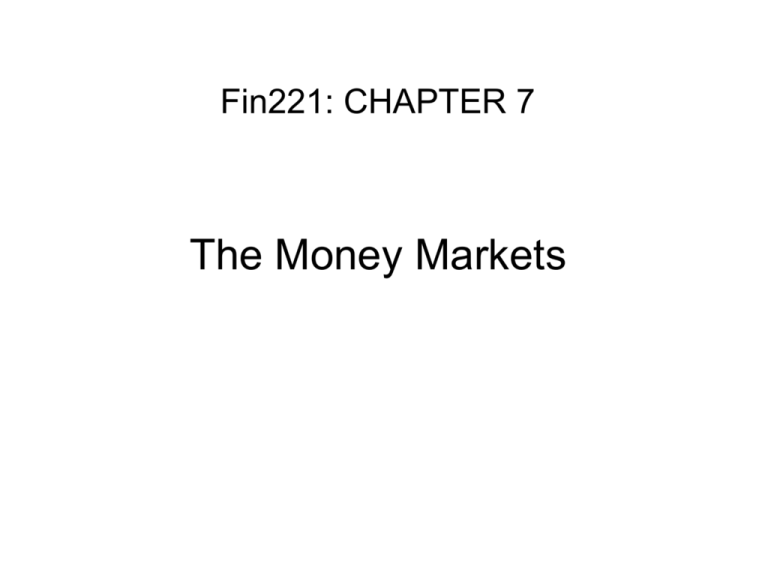
Fin221: CHAPTER 7 The Money Markets Overview of the Money Market • • • • • • • • • Short-term debt market -- most under 120 days. A few high quality borrowers. Many diverse investors. Standardized securities -- one security is a close substitute for another. Good marketability -- secondary market. Large, wholesale open-market transactions. Many brokers and dealers are competitively involved in the money market. Payment in Federal Funds - immediately available funds. Physical possession of securities seldom made 2 Money Market Securities Outstanding 3 Economic Role of Money Market (MM) • The money market is a market for liquidity – Liquidity is stored in MM by investing in MM securities. – Liquidity is bought in MM by issuing securities (borrowing). • Liquidity status of commercial banks is reflected. • Provides a place for Fed’s reserve transactions (open market transactions) • Indicator of economic conditions. 4 Money Market Instruments (securities) • Characteristics of Money Market Instruments Low default risk. Short maturity. High marketability. • The major money market instruments include Treasury bills (T-bills), repurchase agreements, commercial papers, Negotiable CDs, Banker’s acceptances -- etc. 5 Treasury Bills • Characteristics – Sold on discount basis. – Maturities up to one year. – Minimum denomination is usually $10,000, but smaller investors can invest in multiples of $1,000 through the Treasury Direct Program offered by the Fed. – Lowest interest rate of all MM securities is the 3-month T-Bill – T-bills are sold through an auction process using both competitive and noncompetitive bids. 6 Auctioning New Bills • Competitive Bids – Specify price and quantity desired. – Minimum $10,000 & in multiples of $5,000 above $10,000. – Mostly professionals - dealers & banks. – No more than 35 percent of an issue is sold under the competitive bidding process in order to ensure a competitive secondary market. • Non-competitive Bids – All non-competitive bids accepted. – Specify quantity only. – Maximum $1,000,000. – Mostly individuals & small investors. – Pays weighted average price of competitive bids accepted. 7 Treasury Bills • Pricing Treasury Bills – Treasury bills are priced on a bank discount rate basis, a traditional yield calculation. – The bank discount rate, yd , is: y d Par Price 360 100% Par Days To Maturity 8 Treasury Bills – The Wall Journal lists T-Bill yields on a bond equivalent basis where the discounted price is the denominator and 365 days is used as the annualizer. Par Price 365 y 100% be Price Days To Maturity – The effective annual yield assuming compounding a year is: Effective Yield = [(Face Value/Price)365/D -1] x 100%. 9 Repurchase Agreements (Repo) • Bank Financing - Source of funds – Security sold under agreement to repurchase at given price in future. – Way to include corporate business in Federal Funds market. – Negotiated market rate. • Bank Investment – Reverse Repo – Security purchased under agreement to resell at given price in future. – Smaller banks are able to invest excess liquidity in a secured investment. 10 Repurchase Agreements (Repo) • The interest rate on a repo is lower than the fed funds rate, since it is backed up by a security. • Repos are used by the Federal Reserve in open market operations. • Government securities dealers use repos to secure funds to invest in new Treasury issues. • Banks participate in the repo market to secure funds to meet temporary liquidity needs as well as lend funds when they have excess reserves. 11 Commercial Paper • • • • • • Short term (one to 270 days); Unsecured. Large denominations ($100,000 and up) Issued by high - quality borrowers. A wholesale money market instrument. Sold at a discount from par, directly or dealer sold. Backed by bank lines of credit, which support or guarantee quality. • Credit ratings important for commercial paper issuance. • Placement – Directly by a sales force of the borrowing firm. – Indirectly through dealers. 12 The Commercial Paper Market • Major investors – – – – – Commercial banks. Insurance companies. Nonfinancial business firms. Bank trust departments. State and local pension funds. • Banks are involved – – – – Backup lines of credit. Act as agents in issuance. Hold notes in safekeeping. Facilitate payment in Federal Funds. 13 The Commercial Paper Market • Like T-Bills commercial papers are sold on a discount basis, & the same formula could be used to calculate the yield of CP Yield = ([(Face value - purchase price)/ Face value] X 360/ No. of days to maturity) X 100% • Similarly a bond equivalent yield can be calculated for CPs. 14 Negotiable Certificates of Deposit • Characteristics of Negotiable CDs – Large denomination time deposit, less than six month's maturity. – Negotiable - may be sold and traded before maturity. – Issued at face value with coupon rate. – Interest computed on a 360 day year. – Primary market sales have CDs of denominations of at least $100,000. – Secondary market deals are for $1 million or more. – Payment by banks from fed funds in NY. – Interest rates on CDs are higher than on T-Bills - higher credit risk, lower marketability and higher taxability. 15 Negotiable Certificates of Deposit • Development of the CD Market – Issued by Citibank in 1961. – Offset declining demand deposits as a source of funds. • The CD Market – Rate negotiated between buyer and seller. – Market is sensitive to rates above or below the market rates. – Rates are lower for money center banks and are tiered upward for regional banks. – Purchased mainly by corporate businesses. 16 Bankers' Acceptances • Time draft - order to pay in future. • Drafts are drawn on and/or accepted by commercial bank. • Direct liability of bank. • Mostly relate to international trade. • Secondary market - dealer market. • Discounted in market to reflect yield. • Standard maturities of 30, 60, or 90 days max of 180. 17 Creating a Banker's Acceptance • Importer initiates purchase from foreign exporter, payable in future. Importer needs financing; exporter needs assurance of payment in future. • Importer's bank writes irrevocable letter of credit for exporter – Specifies purchase order. – Authorizes exporter to draw time draft on bank. • Importer's bank accepts draft (liability to pay) and creates a banker's acceptance. • Advantage of a banker's acceptance (BA) – Exporter receives funds by selling BA in the market. – Exporter eliminates foreign exchange risk. – Importer's bank guarantees payment of draft in future. 18 Tracing a Banker’s Acceptance Transaction 19 Money Market Participants Major Participants in the Money Market include: • • • • Commercial Banks The Central Bank (The Fed) Dealers in MM Securities Major corporations 20 Commercial Banks • Most important participant in the MM • Bank assets or investments – Treasury bills. – Agency securities. – Bankers' acceptances (from other banks). – Federal Funds sold. – Repurchase agreements (securities purchased under agreements to resell). 21 Commercial Banks,cont. • Bank liabilities or borrowing – Negotiable CDs. – Commercial paper. – Bankers' acceptances. – Federal Funds purchased. – Repurchase agreements (securities sold under agreements to repurchase). • MM securities provides sources and uses of liquidity due to wide fluctuations in loans and deposits. 22 The Central Bank (The Fed) in the Money Markets • Money market securities is the major asset category of the Central Bank. • Open-market operations (buying and selling of MM securities by Fed) is the primary tool for implementing monetary policy. – Purchase - increases member bank reserves. – Sale - decreases member bank reserves. 23 Dealers in MM Securities • Involved in both primary and secondary markets. • Purchases new treasury debt and resells it (primary). • "Makes a market" by buying/selling (dealer) securities (bid/ask). • Purchases are financed by repurchase agreements or fed funds. • Dealers have a very small capital base and are highly leveraged. 24 Money Market Position of Major Participants 25 Interrelationship of Money Market Interest Rates • Various MM instruments are close substitutes in investment portfolios. • Interest rates move together over time. • Deviations from traditional spreads are quickly eliminated by interest rate arbitrage. 26
